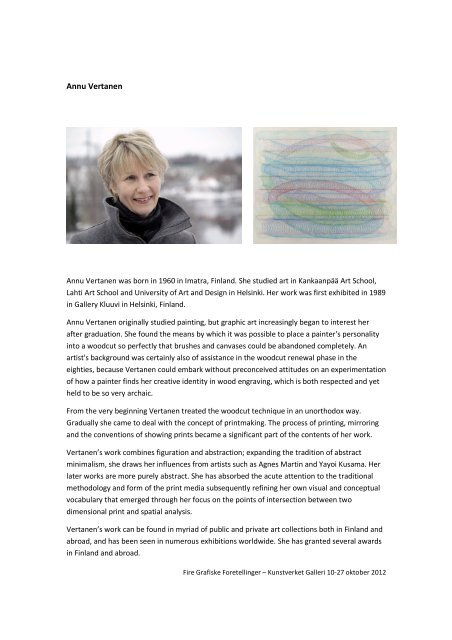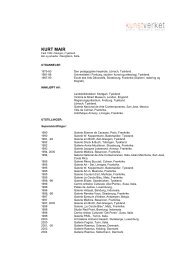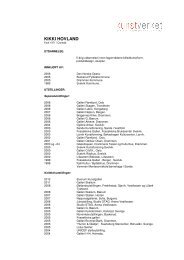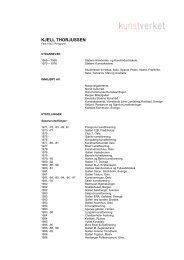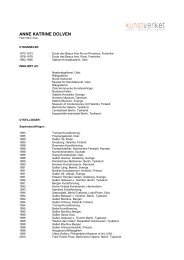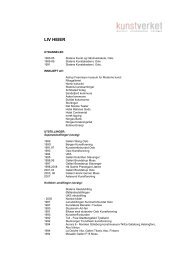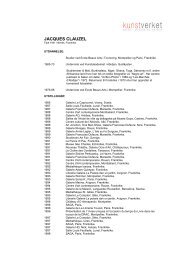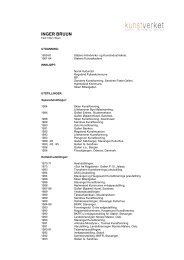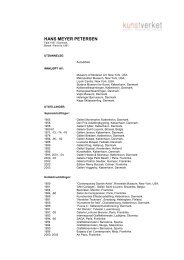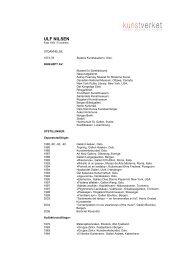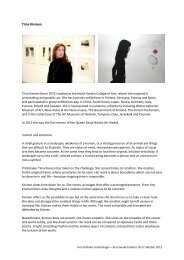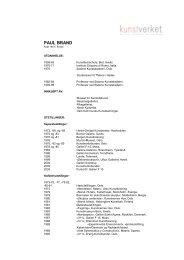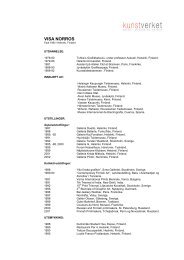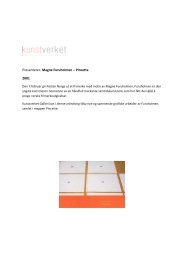Annu Vertanen - Kunstverket Galleri
Annu Vertanen - Kunstverket Galleri
Annu Vertanen - Kunstverket Galleri
You also want an ePaper? Increase the reach of your titles
YUMPU automatically turns print PDFs into web optimized ePapers that Google loves.
<strong>Annu</strong> <strong>Vertanen</strong><br />
<strong>Annu</strong> <strong>Vertanen</strong> was born in 1960 in Imatra, Finland. She studied art in Kankaanpää Art School,<br />
Lahti Art School and University of Art and Design in Helsinki. Her work was first exhibited in 1989<br />
in Gallery Kluuvi in Helsinki, Finland.<br />
<strong>Annu</strong> <strong>Vertanen</strong> originally studied painting, but graphic art increasingly began to interest her<br />
after graduation. She found the means by which it was possible to place a painter's personality<br />
into a woodcut so perfectly that brushes and canvases could be abandoned completely. An<br />
artist's background was certainly also of assistance in the woodcut renewal phase in the<br />
eighties, because <strong>Vertanen</strong> could embark without preconceived attitudes on an experimentation<br />
of how a painter finds her creative identity in wood engraving, which is both respected and yet<br />
held to be so very archaic.<br />
From the very beginning <strong>Vertanen</strong> treated the woodcut technique in an unorthodox way.<br />
Gradually she came to deal with the concept of printmaking. The process of printing, mirroring<br />
and the conventions of showing prints became a significant part of the contents of her work.<br />
<strong>Vertanen</strong>’s work combines figuration and abstraction; expanding the tradition of abstract<br />
minimalism, she draws her influences from artists such as Agnes Martin and Yayoi Kusama. Her<br />
later works are more purely abstract. She has absorbed the acute attention to the traditional<br />
methodology and form of the print media subsequently refining her own visual and conceptual<br />
vocabulary that emerged through her focus on the points of intersection between two<br />
dimensional print and spatial analysis.<br />
<strong>Vertanen</strong>’s work can be found in myriad of public and private art collections both in Finland and<br />
abroad, and has been seen in numerous exhibitions worldwide. She has granted several awards<br />
in Finland and abroad.<br />
Fire Grafiske Foretellinger – <strong>Kunstverket</strong> <strong>Galleri</strong> 10-27 oktober 2012
The pleasure of meaning and the enjoyment of events – the two arts of <strong>Annu</strong> <strong>Vertanen</strong><br />
We do not easily quit the world that meanings have created for us at some indeterminable time<br />
in the future, even though it will happen one day. Roland Barthes distinguishes between the<br />
pleasure derived from the ‘normal’ use of a text and the different, hidden kind of enjoyment of a<br />
text created by the possibility of destroying the order of language. The language of the culture<br />
of pleasure is not used as parts, but as a whole, together with its contexts and even by<br />
stretching the safety nets of metalanguages. For their part, poetic language and modern art<br />
move towards a kind of destruction, consciously testing their limits. Barthes sharply<br />
distinguishes between pleasure and enjoyment despite the fact that one contains the other, as<br />
Erkki Vainikkala writes in his epilogue to the Finnish translation of Barthes’s Pleasure of the Text.<br />
My title compares Barthes’s differentiation to another writer’s distinction, to Riceour’s<br />
dialectical pair of concepts, meaning and events, which describe language as a system – the<br />
production of meanings as the icons of theory – and as an event, i.e., language as a rhetoric that<br />
is always seeking its limits in order to acquire new ‘incomprehensible’ meanings.<br />
In terms of the above distinctions, I try to visualise <strong>Annu</strong> <strong>Vertanen</strong>’s art as a metaphor of<br />
pleasure, tradition, and enjoyment, transgression. Between them the artist accepts the<br />
challenge to combine different impulses into the same performance. The pictures and<br />
performances, meanings and events, are the paradoxes of a way of thinking. In place of the<br />
passage of time, <strong>Vertanen</strong> has decided to use submerged and diffused paints, azur, as a<br />
sensation that tunes the winds, creates light and awakens memories. Even though ultimately<br />
this is not enough, she is in harmony with herself and prepared to present one without the<br />
other, as the other is always present as a memory, a complementary thought.<br />
<strong>Vertanen</strong>’s works are often very large, some even dominate the whole exhibition space with<br />
their multiple, repetitive graphic surfaces. She calls her method ‘wallpapering’. It tells ironically<br />
about her relationship to handicraft: “There’s not much difference between graphic art and<br />
printing wallpaper”. Over the years <strong>Vertanen</strong> has accepted her role as a graphic artist and<br />
decided to do herself what she could have had done by others. A graphic artist is a craftsman.<br />
But who decides how a work is defined A graphic work is by nature flat, paper, a large but<br />
limited print or reproduction, plus the original composition. <strong>Vertanen</strong> still works with coloured<br />
plates on rollers, sampler’s records, as a work is only finished when performed at the concert.<br />
She discovered her graphic expression from the principle of paintings, which she wished to<br />
transfer to her prints. The fact that colours could be printed one on top of the other, not beside<br />
one another, has been taken from the world of painting. Green and red on top of each other,<br />
aluminium, pressing metals, ‘blood’. Different shades of aniline and red run parallel in huge<br />
prints on metal surfaces.<br />
I discover <strong>Vertanen</strong>’s European and American soul mates in the recent history of non-figurative<br />
painting. I can see <strong>Vertanen</strong> in the works of Helen Frankenthaler, Joan Mitchell, Susan<br />
Rothenberg, Gerhard Richter and Sigmar Polke; the same sensitivity, perception – and<br />
straightforwardness. I don’t mean the whole careers of the artists or even the themes of their<br />
most important paintings and works. I mean the first impression that satiates the visual power<br />
with the possibilities of the materials: oil paints and their register, readymade, metal, the<br />
absorbability of unprimed canvas; everything that decides the treatment of the motif and also<br />
the motif itself. How a colour becomes another, keeps its shape, adheres to a new surface,<br />
separates, spreads, runs. Only by hesitating, slowing down, delaying, can <strong>Vertanen</strong>’s works be<br />
Fire Grafiske Foretellinger – <strong>Kunstverket</strong> <strong>Galleri</strong> 10-27 oktober 2012
fully appreciated. Non-figurative forms are only now acquiring meanings with the<br />
interpretations of seeing. Delay means freedom. Thus giving symbolic meanings is uppermost in<br />
modernism, irrespective of the fact that even it is linked to remembering by the delayed search<br />
for contact with our experience, about our bodies, our environment, our other world.<br />
Exaggeratedly, the parts of the world are thrown inside us. There is nothing ‘inside’ that has not<br />
been thrown in. In this respect, <strong>Vertanen</strong>’s abstractions are anthropomorphic, and I do not<br />
believe that the importance of the non-figurative aspects of a work of art can be expressed<br />
without anthropomorphic icons. It was just these icons of representativeness that modernism<br />
passionately wished to eliminate in its struggle for the unobtainable and the unseeable:<br />
principles, universal principles, also from the hereafter. Without noticing that the hereafter<br />
suffers, actually consists of the existing world. This characterisation of mine is supported by<br />
those artists <strong>Vertanen</strong> feels close to: Eva Hesse, Judy Pfaff, Agnes Martin, Terry Winters and<br />
Yayoi Kusama. Common to all their works is a renunciation of the geometrical form language of<br />
modernism and a tendency towards a biomorphic (and anthropomorphic) form.<br />
There is a clear difference between the works of <strong>Vertanen</strong> and similar artists and early abstract<br />
expressionism. When observed, the view mainly focuses on the physical or biological world. The<br />
expressive innovations of painting in the 1950s gave way in the following decade to new<br />
materials, a kind of illumination of the everyday and an ornamental organism. Often almost<br />
presupposing a natural history type register: I’m thinking here of Mark Boyle’s output since the<br />
1960s. The bodily experience or experience of body proliferates. We’re all part of the same thin<br />
layer on the surface of the planet: eye, skin, touch, the living world. <strong>Vertanen</strong>’s name is<br />
repeated as the colour of blood, microscopic images of the body, bundles of nerves, veins and<br />
signal tracks invade the series of prints alongside and beyond the mythical and monumental<br />
expression.<br />
Another area in <strong>Vertanen</strong>’s work is represented by a misty but distant rhythm of repetitive<br />
‘concretism’: stripes like the rumble of lived life, particles dancing on a drumhead. Maintaining a<br />
hypnotic line-drumming like Agnes Martin’s works, background music produced in a colour<br />
cosmos of pastel tones. The iconography of <strong>Vertanen</strong>’s ‘wallpapers’ fills the whole field of vision,<br />
turning and signifying it as a performance space. This is not a question of naming something but<br />
of signifying the difference. Attention is transferred from the object, picture and space to the<br />
viewer. It is a question of how I see, not what I see. <strong>Vertanen</strong>’s surfaces do not answer question<br />
or even invite questions. The printed surfaces expect the viewer to pose the question on the<br />
basis of what he or she sees. Non-figurative opticity, the great theme of post-picturesque<br />
abstraction has been removed. The sequela remains as a stimulus of the relation of the optical<br />
visual space and the concrete space to creation. <strong>Vertanen</strong>’s whole output is characterised by<br />
what the Swedish art theoretician Sven-Olof Wallenstein calls the main interest elements of the<br />
“extended field of painting”: the virtual, two- and three-dimensional subjective experience<br />
which separate from the technique, medium, of painting and in this case also graphic<br />
expression.<br />
<strong>Vertanen</strong> has spent months in India, the United States and Japan. These influences have been<br />
strained into one through the expressions offered by different art forms and methods. An ever<br />
more important reflection of the process of observation has emerged in the background of nonfigurative<br />
expression, the cognition of seeing and the genesis of remembering. The works in the<br />
space perform various tests, as in a laboratory, but perhaps it is not so necessary for the<br />
occasional exhibition visitor to know this. The artist may well have a number of different<br />
Fire Grafiske Foretellinger – <strong>Kunstverket</strong> <strong>Galleri</strong> 10-27 oktober 2012
agendas in the background of her works. The motives, which are not precisely told, may well all<br />
be equally as significant.<br />
The dual expression of <strong>Annu</strong> <strong>Vertanen</strong>’s art presupposes the acceptance of aesthetic experience,<br />
but there is a condition for this. The pleasure of text is ambivalent: the possibility via<br />
germination to present another and at the same time oneself. Looking as a physical stimulus<br />
becomes a possible, original and absolute condition without language: through life. In their<br />
entirety, the possible conditions for life’s pictorial and spatial themes move in parallel in <strong>Annu</strong><br />
<strong>Vertanen</strong>’s works. The artist’s works mean the space we are examining. With her clear starting<br />
point and borderline fusing contact with the world, the enjoyment of events can begin.<br />
Jan Kenneth Weckman<br />
Sources:<br />
Barthes, Roland, Tekstin hurma, Tampere, Vastapaino 1993. Finnish translation of Pleasure of<br />
the Text by Raija Sironen with an epilogue by Erkki Vainikkala.<br />
Riceour, Paul, Tulkinnan teoria, Helsinki, Tutkijaliitto 2000. Finnish translation of Interpretation<br />
Theory.<br />
Wallenstein, Sven-Olov, Den sista bilden [The last picture], Stockholm, Eriksson & Ronnefalk<br />
2002.<br />
Fire Grafiske Foretellinger – <strong>Kunstverket</strong> <strong>Galleri</strong> 10-27 oktober 2012


